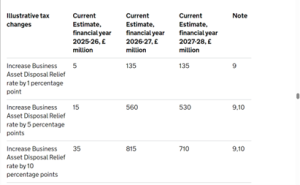
BazBudget
Read more
August 28, 2024 | 8 min read
Author: Andy Wood

In the first of our articles on the pain we might expect from the Starmer-Reeves budget we looked at ‘no pain’ and ‘hurts a little bit’.
But that’s nothing.
Let’s turn up the thumb screws and move on to the next of the next of the Wong-Baker scale…
…Hurts a little bit more.
The ‘hurts a little bit more’ approach might include a potential bonfire of tax reliefs.
After all, we can still say we have not raised taxes even if we’ve torched lots of valuable, and expensive, reliefs right?
The FT recently reported that a 68 estates, all with business assets worth more than £5m, claimed BPR on the estates totalling £1.8b.
This represents a comfortable majority of all BPR relief claimed in 2020/21.
This is likely to be because they represent stakes in unquoted, high value businesses which can qualify for 100% relief.
For some sitting on the left, this might be bad enough. Tax reliefs benefiting the richest in society and all that.
But, for those who are frothy of mouthed already, it will get worse.
The thing is, BPR is not simply restricted to shares (or other interests) in family businesses or trading companies in which the deceased (or transferor) were actively pursued in.
Rather, the relief extends to baskets of shares in many (but not all) of the companies listed on the Alternative Investment Market (“AIM”).
Eh, but you said unquoted?
Indeed, if the company is quoted on Alternative Investment Market (AIM) then it is, well, err, unquoted. Obvs.
In the absence of any other requirements, it is therefore possible for a retired person, say Mrs Miggins, to invest, say, £1m of cold hard cash into a basket of AIM shares.
After two years (or less if one is investing as ‘replacement property’) then the potential IHT liability of £400k is completely removed once the holding period is satisfied.
There is no need to have any involvement in the business. Just ask your financial adviser to pick the shares or the retail product containing them.
It is worth noting that not all AIM companies will qualify for BPR as some will not meet another requirement that the company is ‘trading’.
For example, a company that is mainly investing or, say, dealing in land will not qualify even if the shares are listed on AIM as they do not meet the trading requirement.
Personally, it has always seemed rather strange that a person can obtain an incredibly attractive business tax relief whilst having no involvement or material interest in the business.
One might say that investing in a basket of shares on AIM is likely to be volatile experience. This is risk. However, this is investment risk and not business risk.
Indeed, in recent years, retail products have emerged trying to protect from this volatility / risk.
One could draw an interesting comparison between the case of Mrs Miggins, who gets BPR relief and the substantial curtailing of reliefs for professional landlords who now potentially pay tax on phantom profits if they have leverage.
But this is UK tax.
So, batsh@t craziness pervades.
As such, this aspect of BPR seems highly likely to be floating around in Mrs Reeves’ sink
I have previously suggested solution to this.
Of course, we don’t understand the extent to which AIM relies on this type of money.
Conceivably, removing relief might cause a correction in the market as it becomes less attractive.
I am unaware of any figures which try to quantify this.
But, even if it does, this seems like an odd distortion as to how passive capital is invested.
Why should the AIM generally benefit?
Why should some companies on the AIM market – those that qualify as trading companies – when others that are listed (investment companies) do not.
Ah yes, the tax relief formerly known as Entrepreneurs Relief.
This relief generally applies to the disposal of business assets – such as shares in trading companies and interests in trading partnerships.
However, a couple of years ago, it was whittled down to a shadow of its former self.
The lifetime limit was butchered from £10m to £1m. The holding period and other requirements were tightened up.
A husk of a relief.
Prior to the changes, ER cost £2.7b a year (ERs previous incarnation, taper relief, was many times more costly for various reasons). The more recent figures are that the more insipid version of the relief is £1.1b a year if one includes the lesser spotted Investors Relief.
The same arguments still circulate that entrepreneurs do not build businesses to get £100k tax saving on an eventual sale.
This is a fair point.
But many entrepreneurs are, perhaps unsurprisingly, happy to concede that 10%, or at least a chunk being subject to 10%, is a fair amount of tax.
Is there a danger that if reliefs are removed and rates go up then there is more sport in looking at other ways of reducing tax?
Even if there is, should we even care?
Government stattos have said the following when it comes to the effectiveness of these changes:

Unlike an increase in the CGT rate, however, there are some actual positive returns from removing the benefits of BADR. Halving the benefit would raise some £1.1b over 3 years.
A full removal, would seemingly result in a war-chest of around £1.6b over the same period.
A drop in the ocean? But a drop, nonetheless.
If there has been a purge on BADR because it is seen as expensive and is largely irrelevant at the time our entrepreneur establishes their business then R&D might be susceptible for the same reasons.
Historically, it has been difficult to criticise R&D. It made everyone all warm and fuzzy inside.
Like a wide-eyed puppy.
But if one looks at the same metrics applied to ER, then R&D relief does not shape up well.
For the year 2021/22, the cost (or ‘support claimed’) was about £7.6b a year – quite a bit more than ER.
However, due to changes in the regime, particularly for SMEs, this is likely to fall substantially in more recent years.
Secondly, like BADR, I am certain that, in many cases, the availability of relief is not a prime mover in the claimant investing in innovation.
Indeed, a historical feature of this regime has been around people having to be told they qualified for relief (and, too often, spuriously so).
In addition, it won’t help that a material proportion of relief often leaks into the hands of claims companies charging contingent fees.
We have seen some tightening of the R&D purse strings more recently. HMRC, having followed its usual arc of going from the sublime to the ridiculous in policing claims, is making a right dog’s dinner of enforcing the regime.
It claims that an extraordinary £1.1b is claimed in error or as a result of fraud. They will no doubt trumpet the dog’s dinner they have made in recent months has brought down fraud (by grinding the system to a standstill).
There has also media reports making serious allegations of fraud against providers. Of course, if this is true, these rogues should be brought to book. However, this is perfect supporting evidence for those who might want to curtail the relief.
Finally, there is also the question of whether it makes sense at all to provide such relief for an enhanced deduction for costs incurred on R&D.
But, bearing in mind the above ‘problems’, might Reeves be tempted to further take the surgical scalpel to this relief?
It is an annual tradition, sometimes twice yearly, we speculate about the government removing the tax relief on pension contributions.
The British Empire was built on such speculation.
But could the stopped clock hypothesis ring true?
Rather than allowing tax relief at the marginal rate, perhaps a flat rate of pension tax relief at 25% might be decided.
This feels very much like squeezing the middle. Generally, the wealthy / high earners simply have little headroom for tax relieved pension contributions anyway, with a Scrooge-like annual allowance for such persons.
Also, attacking those saving for retirement seems pretty mean-spirited. Might a more likely route be to tax pensions when benefits are taken?
Of course, payments of income are already taxed at marginal rates. Could Labour add NICs to larger pension payments?
Additionally, the tax-free lump sum seems vulnerable. Could, say, the first £50k be free of tax but the balance is taxable?
Wealthy retirees might be ripe for some pain.
So, there we have it. Yes, Hurts a little bit more.
Isn’t that enough pain?
No?
Aah, I see. You’re a sadist.
Well, there’s plenty more in the Starmer / Reeves hurt locker.